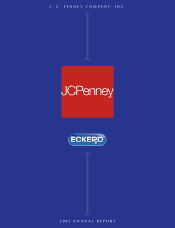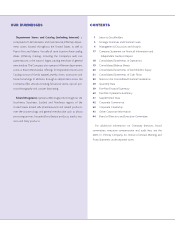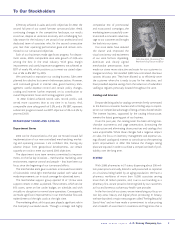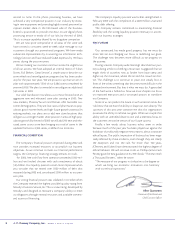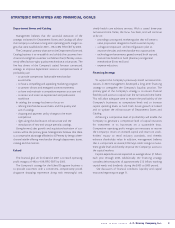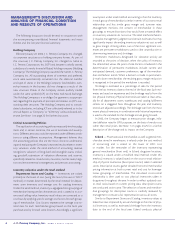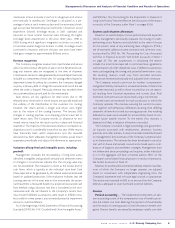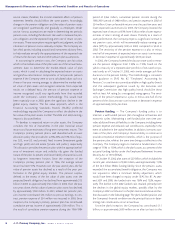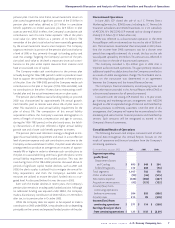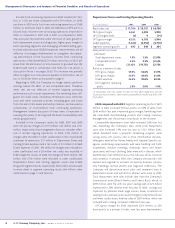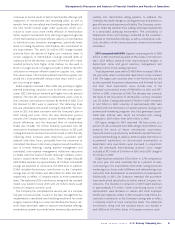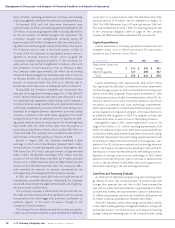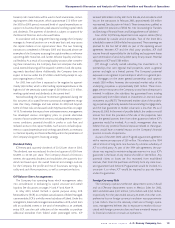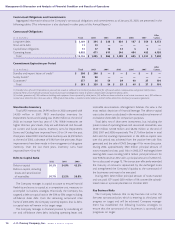JCPenney 2002 Annual Report Download - page 7
Download and view the complete annual report
Please find page 7 of the 2002 JCPenney annual report below. You can navigate through the pages in the report by either clicking on the pages listed below, or by using the keyword search tool below to find specific information within the annual report.
J. C. Penney Company, Inc. 2002 annual report4
MANAGEMENT’S DISCUSSION AND
ANALYSIS OF FINANCIAL CONDITION
AND RESULTS OF OPERATIONS
The following discussion should be read in conjunction with
the accompanying consolidated financial statements and notes
thereto and the five-year financial summary.
Holding Company
Effective January 27, 2002, J. C. Penney Company, Inc. changed
its corporate structure to a holding company format. As part of
this structure, J. C. Penney Company, Inc. changed its name to
J. C. Penney Corporation, Inc. (JCP) and became a wholly owned
subsidiary of a newly formed affiliated holding company (Holding
Company). The Holding Company assumed the name J. C. Penney
Company, Inc. All outstanding shares of common and preferred
stock were automatically converted into the identical number
and type of shares in the Holding Company. Stockholders’ own-
ership interests in the business did not change as a result of the
new structure. Shares of the Company remain publicly traded
under the same symbol (JCP) on the New York Stock Exchange.
The Holding Company is a co-obligor (or guarantor, as appropri-
ate) regarding the payment of principal and interest on JCP’s out-
standing debt securities. The Holding Company and its consoli-
dated subsidiaries, including JCP, are collectively referred to in this
Annual Report as “Company” or “JCPenney,” unless indicated oth-
erwise. See Note 1 on page 22 for further discussion.
Critical Accounting Policies
The application of accounting policies necessarily involves judg-
ment and, in certain instances, the use of estimates and assump-
tions. Different amounts could be reported under different condi-
tions or using different assumptions. Management believes that
the accounting policies that are the most critical to understand-
ing and evaluating the Company’s reported results relate to: inven-
tory valuation under the retail method of accounting; revenue
recognition; valuation of long-lived and intangible assets, includ-
ing goodwill; estimation of valuation allowances and reserves,
specifically related to closed stores, insurance, income taxes, litiga-
tion and environmental contingencies; and pension accounting.
Inventory valuation under the retail method:
Department Stores and Catalog — Inventories are valued
primarily at the lower of cost (using the last-in, first-out or “LIFO”
method) or market determined by the retail method for depart-
ment store inventory and average cost for catalog inventory.
Under the retail method, inventory is segregated into groupings of
merchandise having similar characteristics and is stated at its cur-
rent retail selling value. Inventory retail values are converted to a
cost basis by applying specific average cost factors for each group-
ing of merchandise. Cost factors represent the average cost-to-
retail ratio for each merchandise group based on the fiscal year
purchase activity for each store location. Accordingly, a significant
assumption under retail method accounting is that the inventory
in each group of merchandise is similar in terms of its cost-to-retail
relationship and has similar gross margin and turnover rates.
Management monitors the content of merchandise in these
groupings to ensure distortions that would have a material effect
on inventory valuation do not occur. The retail method inherent-
ly requires management judgment and certain estimates that may
significantly impact the ending inventory valuation at cost as well
as gross margin. Among others, two of the most significant esti-
mates are permanent markdowns used to clear unproductive or
slow-moving inventory and shrinkage.
Permanent markdowns designated for clearance activity are
recorded at the point of decision, when the utility of inventory
has diminished, versus the point of sale. Factors considered in the
determination of permanent markdowns include: current and
anticipated demand, customer preferences, age of the merchan-
dise and fashion trends. When a decision is made to permanent-
ly mark down merchandise, the resulting gross margin reduction
is recognized in the period the markdown is recorded.
Shrinkage is estimated as a percentage of sales for the period
from the last inventory date to the end of the fiscal year. Such esti-
mates are based on experience and the shrinkage results from the
last physical inventory. Physical inventories are taken at least annu-
ally for all department stores, warehouses and catalog fulfillment
centers on a staggered basis throughout the year, and inventory
records are adjusted accordingly. The shrinkage rate from the most
recent physical inventory, in combination with historical experience,
is used as the standard for the shrinkage accrual going forward.
In 2002, the Company began to measure price changes, infla-
tion/deflation rates for LIFO purposes, on the basis of vendor cost
rather than retail prices. See Note 1 on pages 24-25 for a further
description of the change and its impact on the Company.
Eckerd — Pharmaceutical merchandise, as well as general mer-
chandise stored in warehouses, is valued under the cost method
of accounting and is stated at the lower of LIFO cost
or market. For the remainder of the inventory representing
general merchandise (front end) in Eckerd drugstore locations,
inventory is valued under a modified retail method. Under this
method, inventory is valued based on the cost-to-retail relation-
ship of physical inventories (descriptive counts) taken in selected
stores. Descriptive counts gather detailed front-end merchandise
pricing information at both current retail and cost for homoge-
neous groupings of merchandise. The calculated cost-to-retail
relationship is then used to cost physical inventories taken in
drugstores throughout the year. In order to reflect updated cost-
to-retail ratios based on current pricing data, descriptive counts
are conducted twice a year. The selection of stores and merchan-
dise groupings for descriptive counts is carefully reviewed by
management to ensure a fair representation across all stores.
Similar to Department Stores and Catalog, inventory values at
Eckerd are also impacted by actual shrinkage at the time of phys-
ical inventory, as well as estimated shrinkage from the inventory
date to the end of the fiscal year. Eckerd conducts physical

